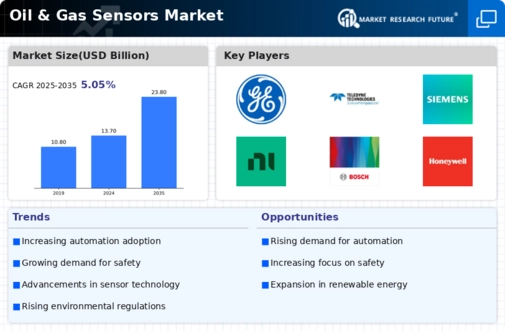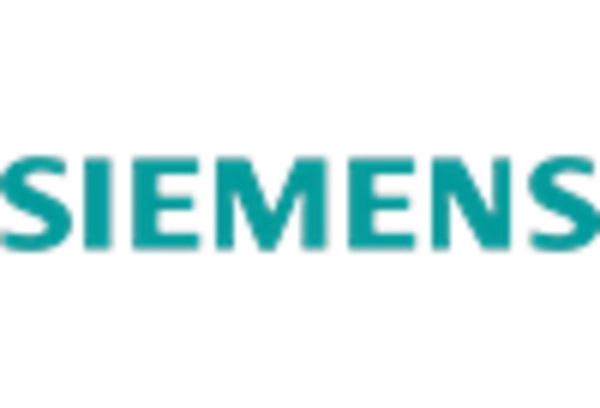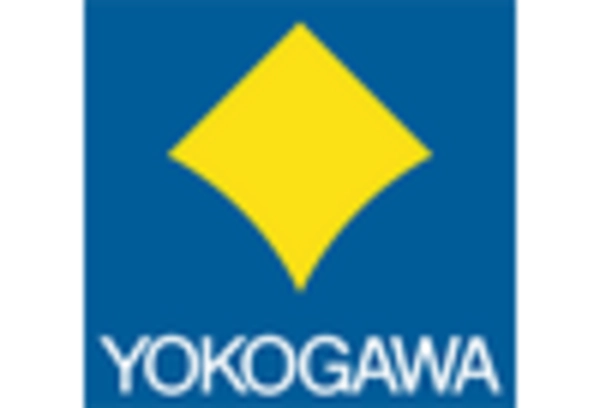-
EXECUTIVE SUMMARY
-
Market Overview
-
Key Findings
-
Market Segmentation
-
Competitive Landscape
-
Challenges and Opportunities
-
Future Outlook
-
MARKET INTRODUCTION
-
Definition
-
Scope of the study
- Research Objective
- Assumption
- Limitations
-
RESEARCH METHODOLOGY
-
Overview
-
Data Mining
-
Secondary Research
-
Primary Research
- Primary Interviews and Information Gathering Process
- Breakdown of Primary Respondents
-
Forecasting Model
-
Market Size Estimation
- Bottom-Up Approach
- Top-Down Approach
-
Data Triangulation
-
Validation
-
MARKET DYNAMICS
-
Overview
-
Drivers
-
Restraints
-
Opportunities
-
MARKET FACTOR ANALYSIS
-
Value chain Analysis
-
Porter's Five Forces Analysis
- Bargaining Power of Suppliers
- Bargaining Power of Buyers
- Threat of New Entrants
- Threat of Substitutes
- Intensity of Rivalry
-
COVID-19 Impact Analysis
- Market Impact Analysis
- Regional Impact
- Opportunity and Threat Analysis
-
OIL GAS SENSORS MARKET, BY TYPE (USD BILLION)
-
Pressure Sensors
-
Temperature Sensors
-
Flow Sensors
-
Level Sensors
-
Chemical Sensors
-
OIL GAS SENSORS MARKET, BY APPLICATION (USD BILLION)
-
Upstream
-
Midstream
-
Downstream
-
Refining
-
Processing
-
OIL GAS SENSORS MARKET, BY TECHNOLOGY (USD BILLION)
-
Wireless Sensors
-
Wired Sensors
-
Smart Sensors
-
Optical Sensors
-
OIL GAS SENSORS MARKET, BY END USE (USD BILLION)
-
Onshore
-
Offshore
-
OIL GAS SENSORS MARKET, BY REGIONAL (USD BILLION)
-
North America
- US
- Canada
-
Europe
- Germany
- UK
- France
- Russia
- Italy
- Spain
- Rest of Europe
-
APAC
- China
- India
- Japan
- South Korea
- Malaysia
- Thailand
- Indonesia
- Rest of APAC
-
South America
- Brazil
- Mexico
- Argentina
- Rest of South America
-
MEA
- GCC Countries
- South Africa
- Rest of MEA
-
COMPETITIVE LANDSCAPE
-
Overview
-
Competitive Analysis
-
Market share Analysis
-
Major Growth Strategy in the Oil Gas Sensors Market
-
Competitive Benchmarking
-
Leading Players in Terms of Number of Developments in the Oil Gas Sensors Market
-
Key developments and growth strategies
- New Product Launch/Service Deployment
- Merger Acquisitions
- Joint Ventures
-
Major Players Financial Matrix
- Sales and Operating Income
- Major Players RD Expenditure. 2023
-
COMPANY PROFILES
-
General Electric
- Financial Overview
- Products Offered
- Key Developments
- SWOT Analysis
- Key Strategies
-
Teledyne Technologies
- Financial Overview
- Products Offered
- Key Developments
- SWOT Analysis
- Key Strategies
-
Siemens
- Financial Overview
- Products Offered
- Key Developments
- SWOT Analysis
- Key Strategies
-
National Instruments
- Financial Overview
- Products Offered
- Key Developments
- SWOT Analysis
- Key Strategies
-
Bosch
- Financial Overview
- Products Offered
- Key Developments
- SWOT Analysis
- Key Strategies
-
ABB
- Financial Overview
- Products Offered
- Key Developments
- SWOT Analysis
- Key Strategies
-
Honeywell
- Financial Overview
- Products Offered
- Key Developments
- SWOT Analysis
- Key Strategies
-
Endress+Hauser
- Financial Overview
- Products Offered
- Key Developments
- SWOT Analysis
- Key Strategies
-
Emerson Electric
- Financial Overview
- Products Offered
- Key Developments
- SWOT Analysis
- Key Strategies
-
Yokogawa Electric
- Financial Overview
- Products Offered
- Key Developments
- SWOT Analysis
- Key Strategies
-
Rockwell Automation
- Financial Overview
- Products Offered
- Key Developments
- SWOT Analysis
- Key Strategies
-
Krohne
- Financial Overview
- Products Offered
- Key Developments
- SWOT Analysis
- Key Strategies
-
Texas Instruments
- Financial Overview
- Products Offered
- Key Developments
- SWOT Analysis
- Key Strategies
-
Ventus Technologies
- Financial Overview
- Products Offered
- Key Developments
- SWOT Analysis
- Key Strategies
-
Schneider Electric
- Financial Overview
- Products Offered
- Key Developments
- SWOT Analysis
- Key Strategies
-
APPENDIX
-
References
-
Related Reports
-
LIST OF TABLES
-
LIST OF ASSUMPTIONS
-
NORTH AMERICA OIL & GAS SENSORS MARKET SIZE ESTIMATES & FORECAST, BY TYPE, 2019-2032 (USD BILLIONS)
-
NORTH AMERICA OIL & GAS SENSORS MARKET SIZE ESTIMATES & FORECAST, BY APPLICATION, 2019-2032 (USD BILLIONS)
-
NORTH AMERICA OIL & GAS SENSORS MARKET SIZE ESTIMATES & FORECAST, BY TECHNOLOGY, 2019-2032 (USD BILLIONS)
-
NORTH AMERICA OIL & GAS SENSORS MARKET SIZE ESTIMATES & FORECAST, BY END USE, 2019-2032 (USD BILLIONS)
-
NORTH AMERICA OIL & GAS SENSORS MARKET SIZE ESTIMATES & FORECAST, BY REGIONAL, 2019-2032 (USD BILLIONS)
-
US OIL & GAS SENSORS MARKET SIZE ESTIMATES & FORECAST, BY TYPE, 2019-2032 (USD BILLIONS)
-
US OIL & GAS SENSORS MARKET SIZE ESTIMATES & FORECAST, BY APPLICATION, 2019-2032 (USD BILLIONS)
-
US OIL & GAS SENSORS MARKET SIZE ESTIMATES & FORECAST, BY TECHNOLOGY, 2019-2032 (USD BILLIONS)
-
US OIL & GAS SENSORS MARKET SIZE ESTIMATES & FORECAST, BY END USE, 2019-2032 (USD BILLIONS)
-
US OIL & GAS SENSORS MARKET SIZE ESTIMATES & FORECAST, BY REGIONAL, 2019-2032 (USD BILLIONS)
-
CANADA OIL & GAS SENSORS MARKET SIZE ESTIMATES & FORECAST, BY TYPE, 2019-2032 (USD BILLIONS)
-
CANADA OIL & GAS SENSORS MARKET SIZE ESTIMATES & FORECAST, BY APPLICATION, 2019-2032 (USD BILLIONS)
-
CANADA OIL & GAS SENSORS MARKET SIZE ESTIMATES & FORECAST, BY TECHNOLOGY, 2019-2032 (USD BILLIONS)
-
CANADA OIL & GAS SENSORS MARKET SIZE ESTIMATES & FORECAST, BY END USE, 2019-2032 (USD BILLIONS)
-
CANADA OIL & GAS SENSORS MARKET SIZE ESTIMATES & FORECAST, BY REGIONAL, 2019-2032 (USD BILLIONS)
-
EUROPE OIL & GAS SENSORS MARKET SIZE ESTIMATES & FORECAST, BY TYPE, 2019-2032 (USD BILLIONS)
-
EUROPE OIL & GAS SENSORS MARKET SIZE ESTIMATES & FORECAST, BY APPLICATION, 2019-2032 (USD BILLIONS)
-
EUROPE OIL & GAS SENSORS MARKET SIZE ESTIMATES & FORECAST, BY TECHNOLOGY, 2019-2032 (USD BILLIONS)
-
EUROPE OIL & GAS SENSORS MARKET SIZE ESTIMATES & FORECAST, BY END USE, 2019-2032 (USD BILLIONS)
-
EUROPE OIL & GAS SENSORS MARKET SIZE ESTIMATES & FORECAST, BY REGIONAL, 2019-2032 (USD BILLIONS)
-
GERMANY OIL & GAS SENSORS MARKET SIZE ESTIMATES & FORECAST, BY TYPE, 2019-2032 (USD BILLIONS)
-
GERMANY OIL & GAS SENSORS MARKET SIZE ESTIMATES & FORECAST, BY APPLICATION, 2019-2032 (USD BILLIONS)
-
GERMANY OIL & GAS SENSORS MARKET SIZE ESTIMATES & FORECAST, BY TECHNOLOGY, 2019-2032 (USD BILLIONS)
-
GERMANY OIL & GAS SENSORS MARKET SIZE ESTIMATES & FORECAST, BY END USE, 2019-2032 (USD BILLIONS)
-
GERMANY OIL & GAS SENSORS MARKET SIZE ESTIMATES & FORECAST, BY REGIONAL, 2019-2032 (USD BILLIONS)
-
UK OIL & GAS SENSORS MARKET SIZE ESTIMATES & FORECAST, BY TYPE, 2019-2032 (USD BILLIONS)
-
UK OIL & GAS SENSORS MARKET SIZE ESTIMATES & FORECAST, BY APPLICATION, 2019-2032 (USD BILLIONS)
-
UK OIL & GAS SENSORS MARKET SIZE ESTIMATES & FORECAST, BY TECHNOLOGY, 2019-2032 (USD BILLIONS)
-
UK OIL & GAS SENSORS MARKET SIZE ESTIMATES & FORECAST, BY END USE, 2019-2032 (USD BILLIONS)
-
UK OIL & GAS SENSORS MARKET SIZE ESTIMATES & FORECAST, BY REGIONAL, 2019-2032 (USD BILLIONS)
-
FRANCE OIL & GAS SENSORS MARKET SIZE ESTIMATES & FORECAST, BY TYPE, 2019-2032 (USD BILLIONS)
-
FRANCE OIL & GAS SENSORS MARKET SIZE ESTIMATES & FORECAST, BY APPLICATION, 2019-2032 (USD BILLIONS)
-
FRANCE OIL & GAS SENSORS MARKET SIZE ESTIMATES & FORECAST, BY TECHNOLOGY, 2019-2032 (USD BILLIONS)
-
FRANCE OIL & GAS SENSORS MARKET SIZE ESTIMATES & FORECAST, BY END USE, 2019-2032 (USD BILLIONS)
-
FRANCE OIL & GAS SENSORS MARKET SIZE ESTIMATES & FORECAST, BY REGIONAL, 2019-2032 (USD BILLIONS)
-
RUSSIA OIL & GAS SENSORS MARKET SIZE ESTIMATES & FORECAST, BY TYPE, 2019-2032 (USD BILLIONS)
-
RUSSIA OIL & GAS SENSORS MARKET SIZE ESTIMATES & FORECAST, BY APPLICATION, 2019-2032 (USD BILLIONS)
-
RUSSIA OIL & GAS SENSORS MARKET SIZE ESTIMATES & FORECAST, BY TECHNOLOGY, 2019-2032 (USD BILLIONS)
-
RUSSIA OIL & GAS SENSORS MARKET SIZE ESTIMATES & FORECAST, BY END USE, 2019-2032 (USD BILLIONS)
-
RUSSIA OIL & GAS SENSORS MARKET SIZE ESTIMATES & FORECAST, BY REGIONAL, 2019-2032 (USD BILLIONS)
-
ITALY OIL & GAS SENSORS MARKET SIZE ESTIMATES & FORECAST, BY TYPE, 2019-2032 (USD BILLIONS)
-
ITALY OIL & GAS SENSORS MARKET SIZE ESTIMATES & FORECAST, BY APPLICATION, 2019-2032 (USD BILLIONS)
-
ITALY OIL & GAS SENSORS MARKET SIZE ESTIMATES & FORECAST, BY TECHNOLOGY, 2019-2032 (USD BILLIONS)
-
ITALY OIL & GAS SENSORS MARKET SIZE ESTIMATES & FORECAST, BY END USE, 2019-2032 (USD BILLIONS)
-
ITALY OIL & GAS SENSORS MARKET SIZE ESTIMATES & FORECAST, BY REGIONAL, 2019-2032 (USD BILLIONS)
-
SPAIN OIL & GAS SENSORS MARKET SIZE ESTIMATES & FORECAST, BY TYPE, 2019-2032 (USD BILLIONS)
-
SPAIN OIL & GAS SENSORS MARKET SIZE ESTIMATES & FORECAST, BY APPLICATION, 2019-2032 (USD BILLIONS)
-
SPAIN OIL & GAS SENSORS MARKET SIZE ESTIMATES & FORECAST, BY TECHNOLOGY, 2019-2032 (USD BILLIONS)
-
SPAIN OIL & GAS SENSORS MARKET SIZE ESTIMATES & FORECAST, BY END USE, 2019-2032 (USD BILLIONS)
-
SPAIN OIL & GAS SENSORS MARKET SIZE ESTIMATES & FORECAST, BY REGIONAL, 2019-2032 (USD BILLIONS)
-
REST OF EUROPE OIL & GAS SENSORS MARKET SIZE ESTIMATES & FORECAST, BY TYPE, 2019-2032 (USD BILLIONS)
-
REST OF EUROPE OIL & GAS SENSORS MARKET SIZE ESTIMATES & FORECAST, BY APPLICATION, 2019-2032 (USD BILLIONS)
-
REST OF EUROPE OIL & GAS SENSORS MARKET SIZE ESTIMATES & FORECAST, BY TECHNOLOGY, 2019-2032 (USD BILLIONS)
-
REST OF EUROPE OIL & GAS SENSORS MARKET SIZE ESTIMATES & FORECAST, BY END USE, 2019-2032 (USD BILLIONS)
-
REST OF EUROPE OIL & GAS SENSORS MARKET SIZE ESTIMATES & FORECAST, BY REGIONAL, 2019-2032 (USD BILLIONS)
-
APAC OIL & GAS SENSORS MARKET SIZE ESTIMATES & FORECAST, BY TYPE, 2019-2032 (USD BILLIONS)
-
APAC OIL & GAS SENSORS MARKET SIZE ESTIMATES & FORECAST, BY APPLICATION, 2019-2032 (USD BILLIONS)
-
APAC OIL & GAS SENSORS MARKET SIZE ESTIMATES & FORECAST, BY TECHNOLOGY, 2019-2032 (USD BILLIONS)
-
APAC OIL & GAS SENSORS MARKET SIZE ESTIMATES & FORECAST, BY END USE, 2019-2032 (USD BILLIONS)
-
APAC OIL & GAS SENSORS MARKET SIZE ESTIMATES & FORECAST, BY REGIONAL, 2019-2032 (USD BILLIONS)
-
CHINA OIL & GAS SENSORS MARKET SIZE ESTIMATES & FORECAST, BY TYPE, 2019-2032 (USD BILLIONS)
-
CHINA OIL & GAS SENSORS MARKET SIZE ESTIMATES & FORECAST, BY APPLICATION, 2019-2032 (USD BILLIONS)
-
CHINA OIL & GAS SENSORS MARKET SIZE ESTIMATES & FORECAST, BY TECHNOLOGY, 2019-2032 (USD BILLIONS)
-
CHINA OIL & GAS SENSORS MARKET SIZE ESTIMATES & FORECAST, BY END USE, 2019-2032 (USD BILLIONS)
-
CHINA OIL & GAS SENSORS MARKET SIZE ESTIMATES & FORECAST, BY REGIONAL, 2019-2032 (USD BILLIONS)
-
INDIA OIL & GAS SENSORS MARKET SIZE ESTIMATES & FORECAST, BY TYPE, 2019-2032 (USD BILLIONS)
-
INDIA OIL & GAS SENSORS MARKET SIZE ESTIMATES & FORECAST, BY APPLICATION, 2019-2032 (USD BILLIONS)
-
INDIA OIL & GAS SENSORS MARKET SIZE ESTIMATES & FORECAST, BY TECHNOLOGY, 2019-2032 (USD BILLIONS)
-
INDIA OIL & GAS SENSORS MARKET SIZE ESTIMATES & FORECAST, BY END USE, 2019-2032 (USD BILLIONS)
-
INDIA OIL & GAS SENSORS MARKET SIZE ESTIMATES & FORECAST, BY REGIONAL, 2019-2032 (USD BILLIONS)
-
JAPAN OIL & GAS SENSORS MARKET SIZE ESTIMATES & FORECAST, BY TYPE, 2019-2032 (USD BILLIONS)
-
JAPAN OIL & GAS SENSORS MARKET SIZE ESTIMATES & FORECAST, BY APPLICATION, 2019-2032 (USD BILLIONS)
-
JAPAN OIL & GAS SENSORS MARKET SIZE ESTIMATES & FORECAST, BY TECHNOLOGY, 2019-2032 (USD BILLIONS)
-
JAPAN OIL & GAS SENSORS MARKET SIZE ESTIMATES & FORECAST, BY END USE, 2019-2032 (USD BILLIONS)
-
JAPAN OIL & GAS SENSORS MARKET SIZE ESTIMATES & FORECAST, BY REGIONAL, 2019-2032 (USD BILLIONS)
-
SOUTH KOREA OIL & GAS SENSORS MARKET SIZE ESTIMATES & FORECAST, BY TYPE, 2019-2032 (USD BILLIONS)
-
SOUTH KOREA OIL & GAS SENSORS MARKET SIZE ESTIMATES & FORECAST, BY APPLICATION, 2019-2032 (USD BILLIONS)
-
SOUTH KOREA OIL & GAS SENSORS MARKET SIZE ESTIMATES & FORECAST, BY TECHNOLOGY, 2019-2032 (USD BILLIONS)
-
SOUTH KOREA OIL & GAS SENSORS MARKET SIZE ESTIMATES & FORECAST, BY END USE, 2019-2032 (USD BILLIONS)
-
SOUTH KOREA OIL & GAS SENSORS MARKET SIZE ESTIMATES & FORECAST, BY REGIONAL, 2019-2032 (USD BILLIONS)
-
MALAYSIA OIL & GAS SENSORS MARKET SIZE ESTIMATES & FORECAST, BY TYPE, 2019-2032 (USD BILLIONS)
-
MALAYSIA OIL & GAS SENSORS MARKET SIZE ESTIMATES & FORECAST, BY APPLICATION, 2019-2032 (USD BILLIONS)
-
MALAYSIA OIL & GAS SENSORS MARKET SIZE ESTIMATES & FORECAST, BY TECHNOLOGY, 2019-2032 (USD BILLIONS)
-
MALAYSIA OIL & GAS SENSORS MARKET SIZE ESTIMATES & FORECAST, BY END USE, 2019-2032 (USD BILLIONS)
-
MALAYSIA OIL & GAS SENSORS MARKET SIZE ESTIMATES & FORECAST, BY REGIONAL, 2019-2032 (USD BILLIONS)
-
THAILAND OIL & GAS SENSORS MARKET SIZE ESTIMATES & FORECAST, BY TYPE, 2019-2032 (USD BILLIONS)
-
THAILAND OIL & GAS SENSORS MARKET SIZE ESTIMATES & FORECAST, BY APPLICATION, 2019-2032 (USD BILLIONS)
-
THAILAND OIL & GAS SENSORS MARKET SIZE ESTIMATES & FORECAST, BY TECHNOLOGY, 2019-2032 (USD BILLIONS)
-
THAILAND OIL & GAS SENSORS MARKET SIZE ESTIMATES & FORECAST, BY END USE, 2019-2032 (USD BILLIONS)
-
THAILAND OIL & GAS SENSORS MARKET SIZE ESTIMATES & FORECAST, BY REGIONAL, 2019-2032 (USD BILLIONS)
-
INDONESIA OIL & GAS SENSORS MARKET SIZE ESTIMATES & FORECAST, BY TYPE, 2019-2032 (USD BILLIONS)
-
INDONESIA OIL & GAS SENSORS MARKET SIZE ESTIMATES & FORECAST, BY APPLICATION, 2019-2032 (USD BILLIONS)
-
INDONESIA OIL & GAS SENSORS MARKET SIZE ESTIMATES & FORECAST, BY TECHNOLOGY, 2019-2032 (USD BILLIONS)
-
INDONESIA OIL & GAS SENSORS MARKET SIZE ESTIMATES & FORECAST, BY END USE, 2019-2032 (USD BILLIONS)
-
INDONESIA OIL & GAS SENSORS MARKET SIZE ESTIMATES & FORECAST, BY REGIONAL, 2019-2032 (USD BILLIONS)
-
REST OF APAC OIL & GAS SENSORS MARKET SIZE ESTIMATES & FORECAST, BY TYPE, 2019-2032 (USD BILLIONS)
-
REST OF APAC OIL & GAS SENSORS MARKET SIZE ESTIMATES & FORECAST, BY APPLICATION, 2019-2032 (USD BILLIONS)
-
REST OF APAC OIL & GAS SENSORS MARKET SIZE ESTIMATES & FORECAST, BY TECHNOLOGY, 2019-2032 (USD BILLIONS)
-
REST OF APAC OIL & GAS SENSORS MARKET SIZE ESTIMATES & FORECAST, BY END USE, 2019-2032 (USD BILLIONS)
-
REST OF APAC OIL & GAS SENSORS MARKET SIZE ESTIMATES & FORECAST, BY REGIONAL, 2019-2032 (USD BILLIONS)
-
SOUTH AMERICA OIL & GAS SENSORS MARKET SIZE ESTIMATES & FORECAST, BY TYPE, 2019-2032 (USD BILLIONS)
-
SOUTH AMERICA OIL & GAS SENSORS MARKET SIZE ESTIMATES & FORECAST, BY APPLICATION, 2019-2032 (USD BILLIONS)
-
SOUTH AMERICA OIL & GAS SENSORS MARKET SIZE ESTIMATES & FORECAST, BY TECHNOLOGY, 2019-2032 (USD BILLIONS)
-
SOUTH AMERICA OIL & GAS SENSORS MARKET SIZE ESTIMATES & FORECAST, BY END USE, 2019-2032 (USD BILLIONS)
-
SOUTH AMERICA OIL & GAS SENSORS MARKET SIZE ESTIMATES & FORECAST, BY REGIONAL, 2019-2032 (USD BILLIONS)
-
BRAZIL OIL & GAS SENSORS MARKET SIZE ESTIMATES & FORECAST, BY TYPE, 2019-2032 (USD BILLIONS)
-
BRAZIL OIL & GAS SENSORS MARKET SIZE ESTIMATES & FORECAST, BY APPLICATION, 2019-2032 (USD BILLIONS)
-
BRAZIL OIL & GAS SENSORS MARKET SIZE ESTIMATES & FORECAST, BY TECHNOLOGY, 2019-2032 (USD BILLIONS)
-
BRAZIL OIL & GAS SENSORS MARKET SIZE ESTIMATES & FORECAST, BY END USE, 2019-2032 (USD BILLIONS)
-
BRAZIL OIL & GAS SENSORS MARKET SIZE ESTIMATES & FORECAST, BY REGIONAL, 2019-2032 (USD BILLIONS)
-
MEXICO OIL & GAS SENSORS MARKET SIZE ESTIMATES & FORECAST, BY TYPE, 2019-2032 (USD BILLIONS)
-
MEXICO OIL & GAS SENSORS MARKET SIZE ESTIMATES & FORECAST, BY APPLICATION, 2019-2032 (USD BILLIONS)
-
MEXICO OIL & GAS SENSORS MARKET SIZE ESTIMATES & FORECAST, BY TECHNOLOGY, 2019-2032 (USD BILLIONS)
-
MEXICO OIL & GAS SENSORS MARKET SIZE ESTIMATES & FORECAST, BY END USE, 2019-2032 (USD BILLIONS)
-
MEXICO OIL & GAS SENSORS MARKET SIZE ESTIMATES & FORECAST, BY REGIONAL, 2019-2032 (USD BILLIONS)
-
ARGENTINA OIL & GAS SENSORS MARKET SIZE ESTIMATES & FORECAST, BY TYPE, 2019-2032 (USD BILLIONS)
-
ARGENTINA OIL & GAS SENSORS MARKET SIZE ESTIMATES & FORECAST, BY APPLICATION, 2019-2032 (USD BILLIONS)
-
ARGENTINA OIL & GAS SENSORS MARKET SIZE ESTIMATES & FORECAST, BY TECHNOLOGY, 2019-2032 (USD BILLIONS)
-
ARGENTINA OIL & GAS SENSORS MARKET SIZE ESTIMATES & FORECAST, BY END USE, 2019-2032 (USD BILLIONS)
-
ARGENTINA OIL & GAS SENSORS MARKET SIZE ESTIMATES & FORECAST, BY REGIONAL, 2019-2032 (USD BILLIONS)
-
REST OF SOUTH AMERICA OIL & GAS SENSORS MARKET SIZE ESTIMATES & FORECAST, BY TYPE, 2019-2032 (USD BILLIONS)
-
REST OF SOUTH AMERICA OIL & GAS SENSORS MARKET SIZE ESTIMATES & FORECAST, BY APPLICATION, 2019-2032 (USD BILLIONS)
-
REST OF SOUTH AMERICA OIL & GAS SENSORS MARKET SIZE ESTIMATES & FORECAST, BY TECHNOLOGY, 2019-2032 (USD BILLIONS)
-
REST OF SOUTH AMERICA OIL & GAS SENSORS MARKET SIZE ESTIMATES & FORECAST, BY END USE, 2019-2032 (USD BILLIONS)
-
REST OF SOUTH AMERICA OIL & GAS SENSORS MARKET SIZE ESTIMATES & FORECAST, BY REGIONAL, 2019-2032 (USD BILLIONS)
-
MEA OIL & GAS SENSORS MARKET SIZE ESTIMATES & FORECAST, BY TYPE, 2019-2032 (USD BILLIONS)
-
MEA OIL & GAS SENSORS MARKET SIZE ESTIMATES & FORECAST, BY APPLICATION, 2019-2032 (USD BILLIONS)
-
MEA OIL & GAS SENSORS MARKET SIZE ESTIMATES & FORECAST, BY TECHNOLOGY, 2019-2032 (USD BILLIONS)
-
MEA OIL & GAS SENSORS MARKET SIZE ESTIMATES & FORECAST, BY END USE, 2019-2032 (USD BILLIONS)
-
MEA OIL & GAS SENSORS MARKET SIZE ESTIMATES & FORECAST, BY REGIONAL, 2019-2032 (USD BILLIONS)
-
GCC COUNTRIES OIL & GAS SENSORS MARKET SIZE ESTIMATES & FORECAST, BY TYPE, 2019-2032 (USD BILLIONS)
-
GCC COUNTRIES OIL & GAS SENSORS MARKET SIZE ESTIMATES & FORECAST, BY APPLICATION, 2019-2032 (USD BILLIONS)
-
GCC COUNTRIES OIL & GAS SENSORS MARKET SIZE ESTIMATES & FORECAST, BY TECHNOLOGY, 2019-2032 (USD BILLIONS)
-
GCC COUNTRIES OIL & GAS SENSORS MARKET SIZE ESTIMATES & FORECAST, BY END USE, 2019-2032 (USD BILLIONS)
-
GCC COUNTRIES OIL & GAS SENSORS MARKET SIZE ESTIMATES & FORECAST, BY REGIONAL, 2019-2032 (USD BILLIONS)
-
SOUTH AFRICA OIL & GAS SENSORS MARKET SIZE ESTIMATES & FORECAST, BY TYPE, 2019-2032 (USD BILLIONS)
-
SOUTH AFRICA OIL & GAS SENSORS MARKET SIZE ESTIMATES & FORECAST, BY APPLICATION, 2019-2032 (USD BILLIONS)
-
SOUTH AFRICA OIL & GAS SENSORS MARKET SIZE ESTIMATES & FORECAST, BY TECHNOLOGY, 2019-2032 (USD BILLIONS)
-
SOUTH AFRICA OIL & GAS SENSORS MARKET SIZE ESTIMATES & FORECAST, BY END USE, 2019-2032 (USD BILLIONS)
-
SOUTH AFRICA OIL & GAS SENSORS MARKET SIZE ESTIMATES & FORECAST, BY REGIONAL, 2019-2032 (USD BILLIONS)
-
REST OF MEA OIL & GAS SENSORS MARKET SIZE ESTIMATES & FORECAST, BY TYPE, 2019-2032 (USD BILLIONS)
-
REST OF MEA OIL & GAS SENSORS MARKET SIZE ESTIMATES & FORECAST, BY APPLICATION, 2019-2032 (USD BILLIONS)
-
REST OF MEA OIL & GAS SENSORS MARKET SIZE ESTIMATES & FORECAST, BY TECHNOLOGY, 2019-2032 (USD BILLIONS)
-
REST OF MEA OIL & GAS SENSORS MARKET SIZE ESTIMATES & FORECAST, BY END USE, 2019-2032 (USD BILLIONS)
-
REST OF MEA OIL & GAS SENSORS MARKET SIZE ESTIMATES & FORECAST, BY REGIONAL, 2019-2032 (USD BILLIONS)
-
PRODUCT LAUNCH/PRODUCT DEVELOPMENT/APPROVAL
-
ACQUISITION/PARTNERSHIP
-
LIST OF FIGURES
-
MARKET SYNOPSIS
-
NORTH AMERICA OIL & GAS SENSORS MARKET ANALYSIS
-
US OIL & GAS SENSORS MARKET ANALYSIS BY TYPE
-
US OIL & GAS SENSORS MARKET ANALYSIS BY APPLICATION
-
US OIL & GAS SENSORS MARKET ANALYSIS BY TECHNOLOGY
-
US OIL & GAS SENSORS MARKET ANALYSIS BY END USE
-
US OIL & GAS SENSORS MARKET ANALYSIS BY REGIONAL
-
CANADA OIL & GAS SENSORS MARKET ANALYSIS BY TYPE
-
CANADA OIL & GAS SENSORS MARKET ANALYSIS BY APPLICATION
-
CANADA OIL & GAS SENSORS MARKET ANALYSIS BY TECHNOLOGY
-
CANADA OIL & GAS SENSORS MARKET ANALYSIS BY END USE
-
CANADA OIL & GAS SENSORS MARKET ANALYSIS BY REGIONAL
-
EUROPE OIL & GAS SENSORS MARKET ANALYSIS
-
GERMANY OIL & GAS SENSORS MARKET ANALYSIS BY TYPE
-
GERMANY OIL & GAS SENSORS MARKET ANALYSIS BY APPLICATION
-
GERMANY OIL & GAS SENSORS MARKET ANALYSIS BY TECHNOLOGY
-
GERMANY OIL & GAS SENSORS MARKET ANALYSIS BY END USE
-
GERMANY OIL & GAS SENSORS MARKET ANALYSIS BY REGIONAL
-
UK OIL & GAS SENSORS MARKET ANALYSIS BY TYPE
-
UK OIL & GAS SENSORS MARKET ANALYSIS BY APPLICATION
-
UK OIL & GAS SENSORS MARKET ANALYSIS BY TECHNOLOGY
-
UK OIL & GAS SENSORS MARKET ANALYSIS BY END USE
-
UK OIL & GAS SENSORS MARKET ANALYSIS BY REGIONAL
-
FRANCE OIL & GAS SENSORS MARKET ANALYSIS BY TYPE
-
FRANCE OIL & GAS SENSORS MARKET ANALYSIS BY APPLICATION
-
FRANCE OIL & GAS SENSORS MARKET ANALYSIS BY TECHNOLOGY
-
FRANCE OIL & GAS SENSORS MARKET ANALYSIS BY END USE
-
FRANCE OIL & GAS SENSORS MARKET ANALYSIS BY REGIONAL
-
RUSSIA OIL & GAS SENSORS MARKET ANALYSIS BY TYPE
-
RUSSIA OIL & GAS SENSORS MARKET ANALYSIS BY APPLICATION
-
RUSSIA OIL & GAS SENSORS MARKET ANALYSIS BY TECHNOLOGY
-
RUSSIA OIL & GAS SENSORS MARKET ANALYSIS BY END USE
-
RUSSIA OIL & GAS SENSORS MARKET ANALYSIS BY REGIONAL
-
ITALY OIL & GAS SENSORS MARKET ANALYSIS BY TYPE
-
ITALY OIL & GAS SENSORS MARKET ANALYSIS BY APPLICATION
-
ITALY OIL & GAS SENSORS MARKET ANALYSIS BY TECHNOLOGY
-
ITALY OIL & GAS SENSORS MARKET ANALYSIS BY END USE
-
ITALY OIL & GAS SENSORS MARKET ANALYSIS BY REGIONAL
-
SPAIN OIL & GAS SENSORS MARKET ANALYSIS BY TYPE
-
SPAIN OIL & GAS SENSORS MARKET ANALYSIS BY APPLICATION
-
SPAIN OIL & GAS SENSORS MARKET ANALYSIS BY TECHNOLOGY
-
SPAIN OIL & GAS SENSORS MARKET ANALYSIS BY END USE
-
SPAIN OIL & GAS SENSORS MARKET ANALYSIS BY REGIONAL
-
REST OF EUROPE OIL & GAS SENSORS MARKET ANALYSIS BY TYPE
-
REST OF EUROPE OIL & GAS SENSORS MARKET ANALYSIS BY APPLICATION
-
REST OF EUROPE OIL & GAS SENSORS MARKET ANALYSIS BY TECHNOLOGY
-
REST OF EUROPE OIL & GAS SENSORS MARKET ANALYSIS BY END USE
-
REST OF EUROPE OIL & GAS SENSORS MARKET ANALYSIS BY REGIONAL
-
APAC OIL & GAS SENSORS MARKET ANALYSIS
-
CHINA OIL & GAS SENSORS MARKET ANALYSIS BY TYPE
-
CHINA OIL & GAS SENSORS MARKET ANALYSIS BY APPLICATION
-
CHINA OIL & GAS SENSORS MARKET ANALYSIS BY TECHNOLOGY
-
CHINA OIL & GAS SENSORS MARKET ANALYSIS BY END USE
-
CHINA OIL & GAS SENSORS MARKET ANALYSIS BY REGIONAL
-
INDIA OIL & GAS SENSORS MARKET ANALYSIS BY TYPE
-
INDIA OIL & GAS SENSORS MARKET ANALYSIS BY APPLICATION
-
INDIA OIL & GAS SENSORS MARKET ANALYSIS BY TECHNOLOGY
-
INDIA OIL & GAS SENSORS MARKET ANALYSIS BY END USE
-
INDIA OIL & GAS SENSORS MARKET ANALYSIS BY REGIONAL
-
JAPAN OIL & GAS SENSORS MARKET ANALYSIS BY TYPE
-
JAPAN OIL & GAS SENSORS MARKET ANALYSIS BY APPLICATION
-
JAPAN OIL & GAS SENSORS MARKET ANALYSIS BY TECHNOLOGY
-
JAPAN OIL & GAS SENSORS MARKET ANALYSIS BY END USE
-
JAPAN OIL & GAS SENSORS MARKET ANALYSIS BY REGIONAL
-
SOUTH KOREA OIL & GAS SENSORS MARKET ANALYSIS BY TYPE
-
SOUTH KOREA OIL & GAS SENSORS MARKET ANALYSIS BY APPLICATION
-
SOUTH KOREA OIL & GAS SENSORS MARKET ANALYSIS BY TECHNOLOGY
-
SOUTH KOREA OIL & GAS SENSORS MARKET ANALYSIS BY END USE
-
SOUTH KOREA OIL & GAS SENSORS MARKET ANALYSIS BY REGIONAL
-
MALAYSIA OIL & GAS SENSORS MARKET ANALYSIS BY TYPE
-
MALAYSIA OIL & GAS SENSORS MARKET ANALYSIS BY APPLICATION
-
MALAYSIA OIL & GAS SENSORS MARKET ANALYSIS BY TECHNOLOGY
-
MALAYSIA OIL & GAS SENSORS MARKET ANALYSIS BY END USE
-
MALAYSIA OIL & GAS SENSORS MARKET ANALYSIS BY REGIONAL
-
THAILAND OIL & GAS SENSORS MARKET ANALYSIS BY TYPE
-
THAILAND OIL & GAS SENSORS MARKET ANALYSIS BY APPLICATION
-
THAILAND OIL & GAS SENSORS MARKET ANALYSIS BY TECHNOLOGY
-
THAILAND OIL & GAS SENSORS MARKET ANALYSIS BY END USE
-
THAILAND OIL & GAS SENSORS MARKET ANALYSIS BY REGIONAL
-
INDONESIA OIL & GAS SENSORS MARKET ANALYSIS BY TYPE
-
INDONESIA OIL & GAS SENSORS MARKET ANALYSIS BY APPLICATION
-
INDONESIA OIL & GAS SENSORS MARKET ANALYSIS BY TECHNOLOGY
-
INDONESIA OIL & GAS SENSORS MARKET ANALYSIS BY END USE
-
INDONESIA OIL & GAS SENSORS MARKET ANALYSIS BY REGIONAL
-
REST OF APAC OIL & GAS SENSORS MARKET ANALYSIS BY TYPE
-
REST OF APAC OIL & GAS SENSORS MARKET ANALYSIS BY APPLICATION
-
REST OF APAC OIL & GAS SENSORS MARKET ANALYSIS BY TECHNOLOGY
-
REST OF APAC OIL & GAS SENSORS MARKET ANALYSIS BY END USE
-
REST OF APAC OIL & GAS SENSORS MARKET ANALYSIS BY REGIONAL
-
SOUTH AMERICA OIL & GAS SENSORS MARKET ANALYSIS
-
BRAZIL OIL & GAS SENSORS MARKET ANALYSIS BY TYPE
-
BRAZIL OIL & GAS SENSORS MARKET ANALYSIS BY APPLICATION
-
BRAZIL OIL & GAS SENSORS MARKET ANALYSIS BY TECHNOLOGY
-
BRAZIL OIL & GAS SENSORS MARKET ANALYSIS BY END USE
-
BRAZIL OIL & GAS SENSORS MARKET ANALYSIS BY REGIONAL
-
MEXICO OIL & GAS SENSORS MARKET ANALYSIS BY TYPE
-
MEXICO OIL & GAS SENSORS MARKET ANALYSIS BY APPLICATION
-
MEXICO OIL & GAS SENSORS MARKET ANALYSIS BY TECHNOLOGY
-
MEXICO OIL & GAS SENSORS MARKET ANALYSIS BY END USE
-
MEXICO OIL & GAS SENSORS MARKET ANALYSIS BY REGIONAL
-
ARGENTINA OIL & GAS SENSORS MARKET ANALYSIS BY TYPE
-
ARGENTINA OIL & GAS SENSORS MARKET ANALYSIS BY APPLICATION
-
ARGENTINA OIL & GAS SENSORS MARKET ANALYSIS BY TECHNOLOGY
-
ARGENTINA OIL & GAS SENSORS MARKET ANALYSIS BY END USE
-
ARGENTINA OIL & GAS SENSORS MARKET ANALYSIS BY REGIONAL
-
REST OF SOUTH AMERICA OIL & GAS SENSORS MARKET ANALYSIS BY TYPE
-
REST OF SOUTH AMERICA OIL & GAS SENSORS MARKET ANALYSIS BY APPLICATION
-
REST OF SOUTH AMERICA OIL & GAS SENSORS MARKET ANALYSIS BY TECHNOLOGY
-
REST OF SOUTH AMERICA OIL & GAS SENSORS MARKET ANALYSIS BY END USE
-
REST OF SOUTH AMERICA OIL & GAS SENSORS MARKET ANALYSIS BY REGIONAL
-
MEA OIL & GAS SENSORS MARKET ANALYSIS
-
GCC COUNTRIES OIL & GAS SENSORS MARKET ANALYSIS BY TYPE
-
GCC COUNTRIES OIL & GAS SENSORS MARKET ANALYSIS BY APPLICATION
-
GCC COUNTRIES OIL & GAS SENSORS MARKET ANALYSIS BY TECHNOLOGY
-
GCC COUNTRIES OIL & GAS SENSORS MARKET ANALYSIS BY END USE
-
GCC COUNTRIES OIL & GAS SENSORS MARKET ANALYSIS BY REGIONAL
-
SOUTH AFRICA OIL & GAS SENSORS MARKET ANALYSIS BY TYPE
-
SOUTH AFRICA OIL & GAS SENSORS MARKET ANALYSIS BY APPLICATION
-
SOUTH AFRICA OIL & GAS SENSORS MARKET ANALYSIS BY TECHNOLOGY
-
SOUTH AFRICA OIL & GAS SENSORS MARKET ANALYSIS BY END USE
-
SOUTH AFRICA OIL & GAS SENSORS MARKET ANALYSIS BY REGIONAL
-
REST OF MEA OIL & GAS SENSORS MARKET ANALYSIS BY TYPE
-
REST OF MEA OIL & GAS SENSORS MARKET ANALYSIS BY APPLICATION
-
REST OF MEA OIL & GAS SENSORS MARKET ANALYSIS BY TECHNOLOGY
-
REST OF MEA OIL & GAS SENSORS MARKET ANALYSIS BY END USE
-
REST OF MEA OIL & GAS SENSORS MARKET ANALYSIS BY REGIONAL
-
KEY BUYING CRITERIA OF OIL & GAS SENSORS MARKET
-
RESEARCH PROCESS OF MRFR
-
DRO ANALYSIS OF OIL & GAS SENSORS MARKET
-
DRIVERS IMPACT ANALYSIS: OIL & GAS SENSORS MARKET
-
RESTRAINTS IMPACT ANALYSIS: OIL & GAS SENSORS MARKET
-
SUPPLY / VALUE CHAIN: OIL & GAS SENSORS MARKET
-
OIL & GAS SENSORS MARKET, BY TYPE, 2024 (% SHARE)
-
OIL & GAS SENSORS MARKET, BY TYPE, 2019 TO 2032 (USD Billions)
-
OIL & GAS SENSORS MARKET, BY APPLICATION, 2024 (% SHARE)
-
OIL & GAS SENSORS MARKET, BY APPLICATION, 2019 TO 2032 (USD Billions)
-
OIL & GAS SENSORS MARKET, BY TECHNOLOGY, 2024 (% SHARE)
-
OIL & GAS SENSORS MARKET, BY TECHNOLOGY, 2019 TO 2032 (USD Billions)
-
OIL & GAS SENSORS MARKET, BY END USE, 2024 (% SHARE)
-
OIL & GAS SENSORS MARKET, BY END USE, 2019 TO 2032 (USD Billions)
-
OIL & GAS SENSORS MARKET, BY REGIONAL, 2024 (% SHARE)
-
OIL & GAS SENSORS MARKET, BY REGIONAL, 2019 TO 2032 (USD Billions)
-
BENCHMARKING OF MAJOR COMPETITORS


















Leave a Comment